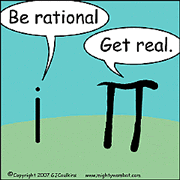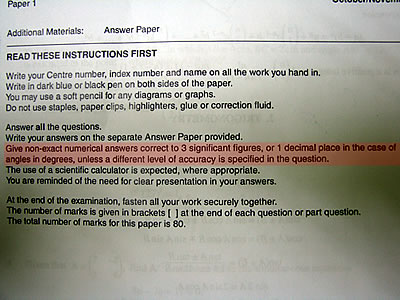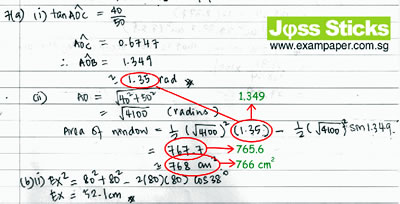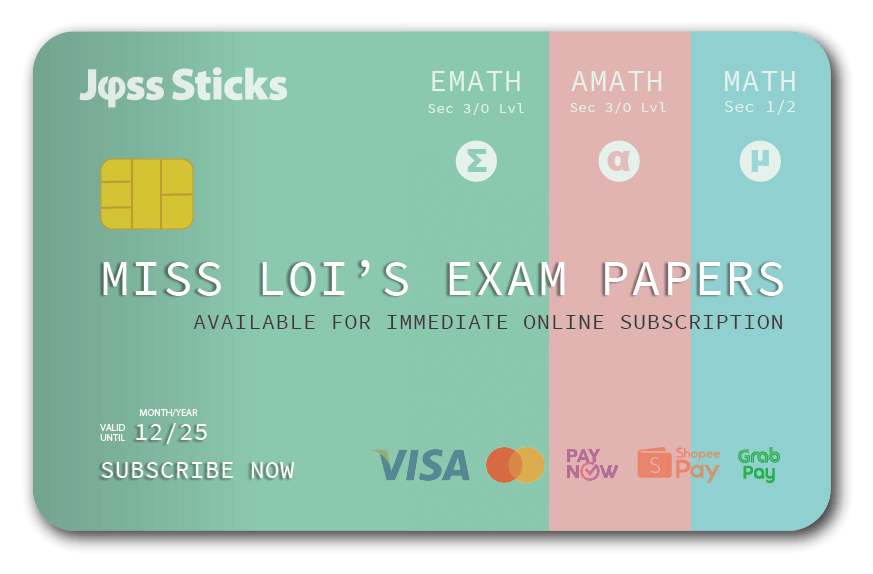
As if the world hasn’t had enough of the geek calendar, today (being 22 July) (Edit: Actually it was yesterday – couldn’t post this in time 🙁 ) happens to be Pi Approximation Day – a day to honour that often-used  fraction to approximate the value of π, though in reality
fraction to approximate the value of π, though in reality  etc. are actually better approximations.
etc. are actually better approximations.
Speaking of approximation, Miss Loi would like to pay a little homage on this day to this most primal and basic of mathematical topics. A topic that many of us first may have first grasped from the Granny of that classic folk song:
『三轮车,跑得快,上面坐個老太太。
要五毛,給一块,你说奇怪不奇怪!』
A topic that resurfaced later in life when a mean taxi uncle (who knew you haven’t been taught approximation in school yet) asked for $10 when the meter showed $9.70.
Or when you somehow instinctively brought along $50 to a sale to grab five items at $9.90 each, for nothing would be left if you had to return home to get more money.
Or that Miss Loi’s weight will always be 50 kg (correct to the nearest 10 kg) everytime you asked her …
In any case, do take a moment today to reflect on the following rules which are, well, supposedly so simple it’s laughable for anyone old enough not to be cheated by mean taxi uncles.
Rounding Off A Number
- Take the digit to the right of the specified (decimal) place/significant figure.
If digit < 5, drop this digit/replace with zeros to keep place value.If digit ≥ 5, add 1 to digit on the left before dropping/replace with zeros to keep place value.要五毛,給一塊, and the 三輪車 Granny is always right!
ALWAYS use/show at least 1 more decimal place/sig. fig. in your intermediate workings and only round off to the required decimal places/sig. fig. in your final answer.
CASE-IN-POINT: See Miss Loi’s O-Level ‘significant’ careless mistake
Rules of Significant Figures
- All non-zero digits (i.e. 1-9) and zeros in between them are significant.
e.g. 12 (2 sig. fig.), 12.5 (3 sig. fig.), 1.025 (4 sig. fig.) Zeros ARE significant UNLESS
- they are at the beginning of a decimal less than 1
e.g. 0.007 (1 sig. fig.), 0.071 (2 sig. fig.), 1.007 (4 sig. fig.) - *they are at the end of a whole number
e.g. *87 000 (2, 3, 4 or 5 sig. fig.), 8.7000 (5 sig. fig.)
*Depends on how estimation is made e.g.
86 999.5 ≈ 87 000 (correct to 5 sig. fig.)
86 995 ≈ 87 000 (correct to 4 sig. fig.)
86 990 ≈ 87 000 (correct to 3 sig. fig.)
86 900 ≈ 87 000 (correct to 2 sig. fig.)
86 000 ≈ 90 000 (correct to 1 sig. fig.)Note how we round off the digit to the right of the required no. of significant figures.
- they are at the beginning of a decimal less than 1
Ultimately, however, do be aware that this seemingly-innocuous topic actually harvests itself in more than half of the questions in any O-Level exam that require numerical answers, as pre-warned on the cover page of every paper (which some of you never ever read 😕 ):

- In addition, what has not (but should have) been stated in the instruction is that when it comes to money, the final answer should be in 2 decimal places (i.e. to the nearest cent) – a leading cause of grief in many exams 🙁
Also do note the following additional note in your syllabus document:
“Unless stated otherwise within a question, three-figure accuracy will be required for answers. This means that four-figure accuracy should be shown throughout the working, including cases where answers are used in subsequent parts of the question. Premature approximation will be penalised, where appropriate. Angles in degrees should be given to one decimal place.”
And in this era of foreign cyborgs and “90% to get A1!” moderation, failure to adhere to the above Commandment has often led to minor loss of marks here and there that could sadly mean the difference between grades, euphoria and despair.

But having said this, Miss Loi and some of her students have always wondered what exactly is a “non-exact numerical” answer?
What if an answer showed exactly 1.2345678 in your calculator – should you leave as such or round it off to 1.23 (3 sig. fig.)?
Hmmm … 你说奇怪不奇怪?

 Miss Loi is a full-time private tutor in Singapore specializing in O-Level Maths tuition. Her life’s calling is to eradicate the terrifying LMBFH Syndrome off the face of this planet. For over years she has been a savior to countless students …
Miss Loi is a full-time private tutor in Singapore specializing in O-Level Maths tuition. Her life’s calling is to eradicate the terrifying LMBFH Syndrome off the face of this planet. For over years she has been a savior to countless students … 





















7 Comments
曜
日
In such unanticipated situation, one should rebel, flaunt the rules, and shock the teacher by penning a heart-felt poem instead!
Roses are red, violets are blue.
I have a dog, but it looks like a cat.
It's very confusing, very much like maths.
Heh :p
曜
日
If your dog looks like a cat
You may need to change your specs :p
And if maths is hard to understand
Maybe a sexy maths tutor can lend a hand 😀
曜
日
what is the marking scheme for paper 1 and 2?
are marks awarded for workings in paper 1?
曜
日
A couple of question was asked here but Miss Loi finds it more appropriate to reply here, since they deal with the topic of this blog post:
"... is it true that candidates should
leave final answers (other than in degrees) to 3 significant figures ONLY if the answer is not exact. E.g. 74.5 / 4, do we leave our final answer as 18.625 since it is exact?"
This has been a longstanding debate amongst anxious students, teachers and schools every year but the straightforward answer is
yes - all exact answers should be left as they are i.e. in the exact number of decimal places.
The not-so-straightforward scenario would be what if your "exact" answer happens to be exactly 1.2345678, as mentioned at the end of this blog post? A certain school even once ascertained that "the answer is deemed to be exact if it doesn't fill up the whole of the calculator's screen". But calculators are created different with different number of digits!
Granted these are freak cases, perhaps it's best to leave the final answer with its full compliment of decimal places or in fraction form, with the remark 'exact' next to it just to convince the examiner that you know what you're doing, should you encounter something like this. Anyone disagree?
" ... use at least 4 significant figures to do working, and if the working includes figures that have been rounded off to 4sf, the final answer should be corrected to 3sf even if it appears as a fraction which is exact?"
Yes, the accuracy of your final answer would have been affected by rounding off the intermediate values in your working. So as a result, your final answer is non-exact.
" ... answers in money should be rounded off to the nearest cent and not 3 significant figures e.g. $245.67 and not $246 (3sf)?"
This should be as clear as day by now: Unless stated otherwise, money should be rounded off to the nearest cent e.g. $100.00
Don't short-change yourself!
曜
日
@Miss Loi: Thanks for the help!
Quote:
" ... answers in money should be rounded off to the nearest cent and not 3 significant figures e.g. $245.67 and not $246 (3sf)?"
This should be as clear as day by now: Unless stated otherwise, money should be rounded off to the nearest cent e.g. $100.00
--
I refer to the O level 2008 Additional Mathematics Suggested Solutions
https://www.exampaper.com.sg/blog/wp-content/uploads/gce-o-level-2008-amaths-4038-paper-2-solutions.pdf
For question 1 (ii), you rounded off your "Value after 18 months" to 3 significant figures. Should the answer be $2529.80 (corrected to nearest cent)?
Could the answer be because when in cents, it depends on the accuracy of the 'p' value which is approximated? Which means that since the 'p' value was already rounded to a number of significant figures (preferred by the candidate but not less than 4), it is not smart to round it to the nearest cent as it means 6 significant figures when the value of 'p' was already rounded off to 5 sf?
曜
日
@Aaron: Your question seems to have ignited one of the controversies of the century as far as O level AMaths go 😛
To be absolutely honest, when Miss Loi made her "clear as day: to the nearest cent" remark she was referring to answers in the Money & Personal Finance topic under the Arithmetic chapter in EMaths, where students are specifically tested on the transactions and values of money, and hence non-exact answers should be left to the nearest cent.
The 2008 AMaths Paper 2 Q1, however, is actually a question on Logarithmic and Exponential functions and hence Miss Loi did the calculations and left the answer, in her usual way for such questions, in 3 sig. fig.
Yes it's an assumption and so in a quest to get a better consensus, she decided to 飞鸽传书 (via her students) this query to some teachers and at the same check some of the standard TYS solutions. And the result is ...
knelt down tosee that the final answer was left in 3 sig. fig.!As such, Miss Loi thinks she'll leave that particular answer in 3 sig. fig. for now. Did you ask your cher's opinion on this?
曜
日
Actually for 1.2345678 (exact)
I feel i have a safer way (I did it for more than once for exams)
1.2345678 (exact) which is approx. to 1.23 (3 s.f.)